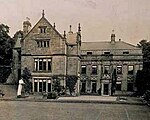Wrexham-Rhos transmitting station
The Wrexham-Rhos transmitting station is a digital television relay of Moel-y-Parc, and forms part of the Wales television region. Despite its name, the station is situated in Moss Village and serves the city of Wrexham, the northern area of Wrexham County Borough and south-western Flintshire. It is a free-standing lattice tower structure serving around 85,000 homes which are unable to receive broadcasts from Moel-y-Parc due to Hope Mountain. This area is traditionally served by English transmitters at Winter Hill and The Wrekin, which have historically provided English-language channels Channel 4 and Channel 5, plus the digital terrestrial services ONdigital/ITV Digital (from 1998 to 2002) and Freeview from 2002 onwards. Wrexham-Rhos was constructed to coincide with the 1977 National Eisteddfod in Wrexham, initially providing S4C and BBC One Wales, later joined by HTV Wales in 1997 and BBC Two Wales in 1999.The DAB digital radio transmitter on the site was switched on in 2013. It had a temporary outage in 2017.
Excerpt from the Wikipedia article Wrexham-Rhos transmitting station (License: CC BY-SA 3.0, Authors).Wrexham-Rhos transmitting station
Clayton Road,
Geographical coordinates (GPS) Address Nearby Places Show on map
Geographical coordinates (GPS)
| Latitude | Longitude |
|---|---|
| N 53.0762 ° | E -3.045 ° |
Address
Wrexham-Rhos
Clayton Road
LL11 6BH , Broughton
Wales, United Kingdom
Open on Google Maps





